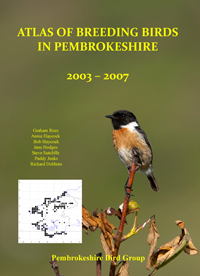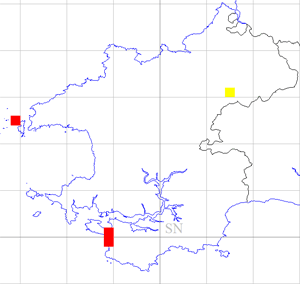Breeding resident and winter visitor
"Resident, one of our commonest birds, nesting in most districts of the county" wrote Mathew in 1894. "Common in suitable moors and wet grounds, although somewhat local in distribution" commented Lockley et al. (1949), who also stated "breeds on the islands". Lloyd's diaries record nesting on the islands of Ramsey, Skokholm and Skomer and in many places on the mainland, ranging from over 35 pairs at Castle Martin Corse and 30 pairs in the boggy ground behind St Govan's Head to smaller scattered groups further north, as at Dowrog, Strumble Head and in the Preseli Mountains at Rosebush and Maenclochog, and at just a few areas in the east such as Ludchurch Common and Carnary.
Lapwings began to decrease thereafter, so that Lockley (1961) was moved to comment that "the number of breeding birds has declined, principally due to high farming and the drainage of marshy fields". This process has continued and many commons have also ceased to be suitable because reduced grazing by cattle, and possibly rabbits, has permitted invasion by rank growth and scrub. A general increase in numbers of foxes and crows may also have been an important factor. Saunders (1976) assessed the Lapwing as breeding "sparsely throughout the county". It is now confined to a few largely coastal areas, and the total population can be accurately estimated at 70 pairs, over half of them on Ramsey Island.
The Lapwing is much more numerous and widespread in the winter, particularly on the wet pastures of the coastal belt where flocks of 200-400 birds are seen frequently. Birds begin to arrive from July, when small parties of mixed adults and juveniles can be encountered flying overland from the north-east, but the bulk arrive at night during October and November. Departure, during March and April, is rapid and at this time they have been seen flying over the Smalls from the direction of Ireland and have been detected by radar departing north-eastwards at night from the mainland of Pembrokeshire (Johnson 1969).
Cold winter weather in the east drives many additional Lapwings to Pembrokeshire. Should the county remain unfrozen they stay, but otherwise many pass on to the south and west; for example 1,150 passed over the Smalls towards Ireland in such conditions in February 1983. Ringing recoveries have shown that some arrive in Pembrokeshire from north-west Europe and that locally-bred birds move down to winter in Iberia.

Fieldwork 1984-88 (based on 478 tetrads)
Red = breeding confirmed = 11
Orange = breeding probable = 7
Yellow = breeding possible = 10
Total tetrads in which registered = 28 (5.9%)
Donovan J.W. & Rees G.H (1994), Birds of Pembrokeshire
 Monday, October 7, 2013 at 10:15AM
Monday, October 7, 2013 at 10:15AM 





